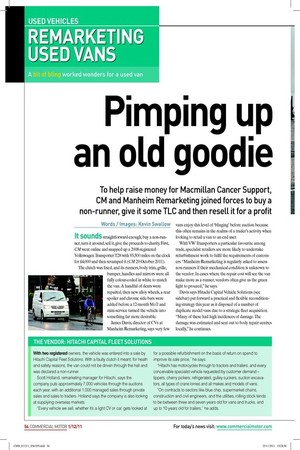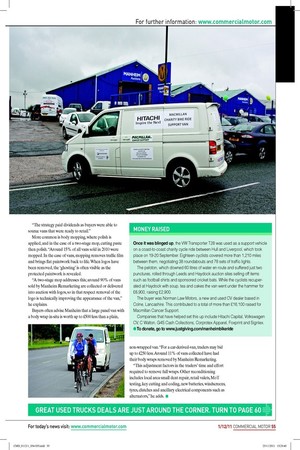Pimping up an old goodie
Page 40

Page 41

If you've noticed an error in this article please click here to report it so we can fix it.
To help raise money for Macmillan Cancer Support, CM and Manheim Remarketing joined forces to buy a non-runner, give it some TLC and then resell it for a profit
Words / Images: Kevin Swallow
It sounds straightforward enough; buy a non-runner, turn it around, sell it, give the proceeds to charity. First, CM went online and snapped up a 2008-registered Volkswagen Transporter T28 with 93,500 miles on the clock for £4,000 and then revamped it (CM 20 October 2011).
The clutch was ixed, and its runners, body trim, grille, bumper, handles and mirrors were all fully colour-coded in white to match the van. A handful of dents were repaired, then new alloy wheels, a rear spoiler and chrome side bars were added before a 12-month MoT and mini-service turned the vehicle into something far more desirable.
James Davis, director of CVs at Manheim Remarketing, says very few vans enjoy this level of ‘blinging’ before auction because this often remains in the realms of a trader’s activity when looking to retail a van to an end user.
With VW Transporters a particular favourite among trade, specialist retailers are more likely to undertake refurbishment work to fulil the requirements of customers. “Manheim Remarketing is regularly asked to assess non-runners if their mechanical condition is unknown to the vendor. In cases where the repair cost will see the van make more as a runner, vendors often give us the green light to proceed,” he says.
Davis says Hitachi Capital Vehicle Solutions (see sidebar) put forward a practical and lexible reconditioning strategy this year as it disposed of a number of duplicate model vans due to a strategic leet acquisition. “Many of these had high incidences of damage. The damage was estimated and sent out to body repair centres locally,” he continues. “The strategy paid dividends as buyers were able to source vans that were ready to retail.” More common is body mopping, where polish is applied, and in the case of a two-stage mop, cutting paste then polish. “Around 15% of all vans sold in 2010 were mopped. In the case of vans, mopping removes trafic ilm and brings lat paintwork back to life. When logos have been removed, the ‘ghosting’ is often visible as the protected paintwork is revealed.
“A two-stage mop addresses this; around 90% of vans sold by Manheim Remarketing are collected or delivered into auction with logos, so in that respect removal of the logo is technically improving the appearance of the van,” he explains.
Buyers often advise Manheim that a large panel van with a body wrap in-situ is worth up to £500 less than a plain, non-wrapped van. “For a car-derived-van, traders may bid up to £250 less. Around 11% of vans collected have had their body wraps removed by Manheim Remarketing.
“This adjustment factors in the traders’ time and effort required to remove full wraps. Other reconditioning includes local area small dent repair, retail valets, MoT testing, key cutting and coding, new batteries, windscreens, tyres, clutches and ancillary electrical components such as alternators,” he adds. ■











































